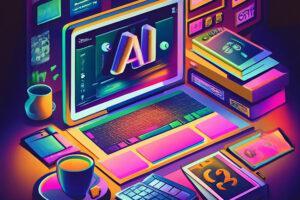In recent years, the integration of AI in eco-friendly design has become a significant trend, reflecting a broader movement towards sustainability. As the world grapples with climate change, the role of technology in fostering a greener future cannot be overstated. Leveraging AI in design processes not only enhances efficiency but also reduces the environmental impact, making it a powerful tool in the quest for sustainability.
The use of AI in eco-friendly design spans various sectors, from architecture to product design, offering innovative solutions to age-old problems. By optimizing resource use and streamlining workflows, AI helps designers create more sustainable products and systems, thereby contributing to a healthier planet.

Understanding the Role of AI in Eco-Friendly Design
AI technologies provide designers with advanced tools to analyze and improve the environmental performance of their projects. For instance, AI algorithms can predict and simulate the environmental impact of a design before it is built, allowing for adjustments that minimize negative outcomes.
In the realm of architecture, AI can optimize building designs to enhance energy efficiency, as discussed in this AI for Architectural Visualization. By analyzing data on sunlight, wind patterns, and other environmental factors, AI helps architects design buildings that use less energy and have a smaller carbon footprint.
AI’s Contribution to Sustainable Product Design
Product designers are also leveraging AI to create eco-friendly products. AI can analyze materials and manufacturing processes to suggest alternatives that reduce waste and energy consumption. This capability is crucial in industries such as electronics, where the environmental impact is significant.
Moreover, AI-driven design tools enable designers to experiment with more sustainable materials and innovative manufacturing techniques, fostering a culture of sustainability in product development. For example, AI can assist in designing products that are easier to recycle or have a longer lifespan, thereby reducing their overall environmental impact.
Case Study: AI in Green Architecture
An excellent example of AI in eco-friendly design can be seen in the construction industry, where AI is used to design buildings that harmonize with their natural surroundings. By integrating AI with traditional architectural practices, designers can create structures that not only minimize environmental harm but also enhance the natural beauty of their settings.
This approach is evident in various eco-friendly buildings worldwide, where AI has been used to select sustainable materials and design energy-efficient systems. The impact of these innovations is not just environmental; they also improve the quality of life for inhabitants by creating healthier living spaces.
AI and Renewable Energy Systems
In the field of renewable energy, AI plays a crucial role in optimizing the design and operation of energy systems. For instance, AI algorithms can predict energy demand and adjust the output of renewable energy sources accordingly, ensuring that energy is used efficiently and waste is minimized.
This capability is particularly important as the world transitions to renewable energy sources. By optimizing energy systems, AI helps reduce the reliance on fossil fuels and promotes the use of renewable energy, which is essential for a sustainable future.
Advancements in AI for Environmental Monitoring
Environmental monitoring is another area where AI is making a significant impact. AI technologies can analyze large datasets from various environmental sensors to detect patterns and predict changes in the environment. This capability allows for more effective monitoring of ecosystems and helps in the early detection of environmental issues.
Such advancements are critical for conservation efforts, as they provide the data needed to make informed decisions about environmental protection and resource management. By using AI for environmental monitoring, we can better understand and address the challenges facing our planet.
Challenges and Opportunities
While the integration of AI in eco-friendly design offers numerous benefits, it also presents challenges. One of the main challenges is ensuring that AI systems are designed and used in ways that align with ethical and environmental standards. This requires ongoing collaboration between technologists, designers, and policymakers.
Despite these challenges, the opportunities presented by AI in eco-friendly design are vast. As AI technologies continue to evolve, they offer new possibilities for creating sustainable solutions that were previously unimaginable. By embracing these opportunities, we can pave the way for a more sustainable future.
Future Prospects of AI in Sustainable Design
Looking ahead, the future of AI in eco-friendly design is bright. As AI technologies become more advanced, they will continue to play a crucial role in driving sustainability across various industries. From reducing waste in manufacturing to optimizing energy consumption in buildings, the potential applications of AI in sustainable design are limitless.
By fostering innovation and encouraging the adoption of sustainable practices, AI can help us build a greener future. As we continue to explore the possibilities of AI in eco-friendly design, we must remain committed to using these technologies responsibly and ethically to ensure that they benefit both people and the planet.
AI in Eco-Friendly Design: An Optimistic Outlook
The integration of AI in eco-friendly design marks a significant step forward in our efforts to create a sustainable future. By harnessing the power of AI, we can design products, buildings, and systems that are not only efficient but also environmentally friendly. This capability is critical as we face the challenges of climate change and work towards a more sustainable world.
The possibilities for AI in eco-friendly design are vast, and the potential benefits are significant. By continuing to innovate and explore new applications for AI in sustainable design, we can create a future where technology and the environment coexist harmoniously.

FAQ Section
1. How is AI used in eco-friendly design?
AI is used in eco-friendly design to optimize resource use, reduce waste, and improve the environmental performance of designs. It helps in analyzing and predicting the environmental impact of designs, allowing for adjustments that minimize negative outcomes.
2. What are the benefits of AI in eco-friendly design?
The benefits of AI in eco-friendly design include increased efficiency, reduced environmental impact, and the ability to create more sustainable products and systems. AI helps designers optimize their designs for energy efficiency and sustainability.
3. What challenges does AI pose to eco-friendly design?
Challenges include ensuring that AI systems align with ethical and environmental standards and addressing the need for collaboration between technologists, designers, and policymakers to use AI responsibly.






